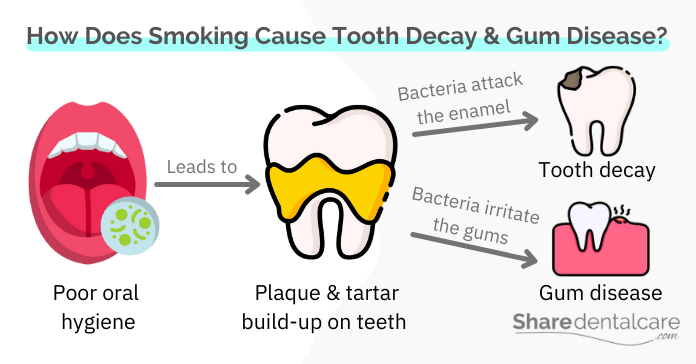Many people are unaware of the link between smoking and oral health. It harms your oral health and can lead to some of the most common dental problems, such as tooth decay and gum disease. Smoking has also been linked with an increased risk of oral cancer. If you are a smoker, you need to consider these facts and start quitting. However, if you are not able to quit, you should at least practice good oral hygiene habits to keep your teeth and gums healthy. In this blog post, we will answer the question “does smoking cause tooth decay and gum disease”, how, and find out how to keep your mouth healthy.
Understanding What Tooth Decay and Gum Disease are
Before we begin to discuss “does smoking cause tooth decay and gum disease?“, let’s take a look at what both diseases are.
- Tooth decay: it is a bacterial infection of the tooth. The bacteria that cause the problem are mainly Streptococcus mutans and lactobacilli. Tooth decay destroys the tooth enamel. If left untreated, the infection will spread to the inner of the tooth (pulp), causing a dental abscess.
- Gum disease: it is a bacterial infection of the gums. The bacteria responsible for gum disease (gingivitis & periodontitis) are anaerobic bacteria. Read more about what bacteria cause gingivitis. Gum disease begins with inflammation and redness of the gums, which progresses to swollen gums and bleeding. In more advanced stages, the infection spreads to the supporting tissues of the teeth, causing tooth loss.
How Does Smoking Cause Tooth Decay and Gum Disease?
Dental plaque is a sticky, colorless film of bacteria that forms on your teeth and gums after eating and drinking. These bacteria decompose the food particles and release acids that attack the tooth enamel and irritate the gums. Plaque bacteria are the primary cause of tooth decay and gum disease.
Smokers have a higher risk of developing oral health problems than non-smokers. Smoking causes tooth decay and gum disease because it increases the plaque build-up in your mouth and does not allow the bacterial acids to wash away. This how does smoking causes tooth decay and gum disease:
- Smoking reduces the flow of saliva in the mouth, which is an important factor for removing bacteria and neutralizing acids produced by them. Saliva also washes away food particles and neutralizes acids from them.
- It weakens your immune system, making it harder for your mouth and body to fight infections.
- Smoking changes the pH level in your mouth, making it less alkaline and more acidic. This destroys the tooth enamel, causing tooth decay.
- Tobacco smoke irritates the gums, causing swelling and redness. Learn more about tobacco’s effects on smokers teeth and gums.

Smoking Can Cause Complications of Tooth Decay and Gum Disease
If you already have gum disease and/or tooth decay, smoking does make them worse and causes complications such as:
- Toothache
- Difficulties in chewing.
- Receding gums.
- Periodontal pockets.
- Teeth sensitivity to hot and cold food and drinks.
- Persistent bad breath.
- Dental abscesses.
- Facial swelling.
- Development of spaces between teeth.
- Loose teeth and eventually tooth loss.
Both smoking and gum disease are linked to serious health problems such as heart disease and strokes. If you are a smoker, make sure to practice good oral hygiene habits to help keep your mouth healthy.
How to Keep Your Mouth Healthy if You’re a Smoker?
If you are a smoker, here are some practical steps you can take to protect your teeth and gums:
- Quit smoking: smoking not only causes tooth decay and gum disease, but it does also increase the risk of cancers, heart diseases, and strokes. So, quitting smoking is the way to keep your mouth and body healthy. If you are not able to quit smoking, try to smoke in moderation.
- Brush your teeth twice a day: clean your teeth and gums regularly with fluoride toothpaste to remove the plaque and food particles.
- Use dental floss: floss at least once a day to prevent the accumulation of food particles between your teeth.
- Eat a healthy diet: eat healthy foods and limit the consumption of sugary foods and drinks.
- Drink lots of water: to keep your mouth moist, neutralize acids, and wash away food particles.
- Visit your dentist: if you have a problem with your teeth or gums, you must visit a dentist for treatment. Also, get regular checkups and professional cleanings at least once every six months.
Does Smoking Cause Tooth Decay & Gum Disease – Conclusion
In conclusion, smoking does cause tooth decay and gum disease. It does so by increasing the plaque bacteria in your mouth, which releases acids that destroy the tooth enamel and irritate the gums. Smoking also slows down saliva production, which is an important factor for removing bacteria and neutralizing acids produced by them. So, if you want to keep your mouth healthy, quit smoking or at least smoke in moderation. Besides, practice good oral hygiene habits and visit your dentist regularly for regular check-ups and professional teeth cleanings.